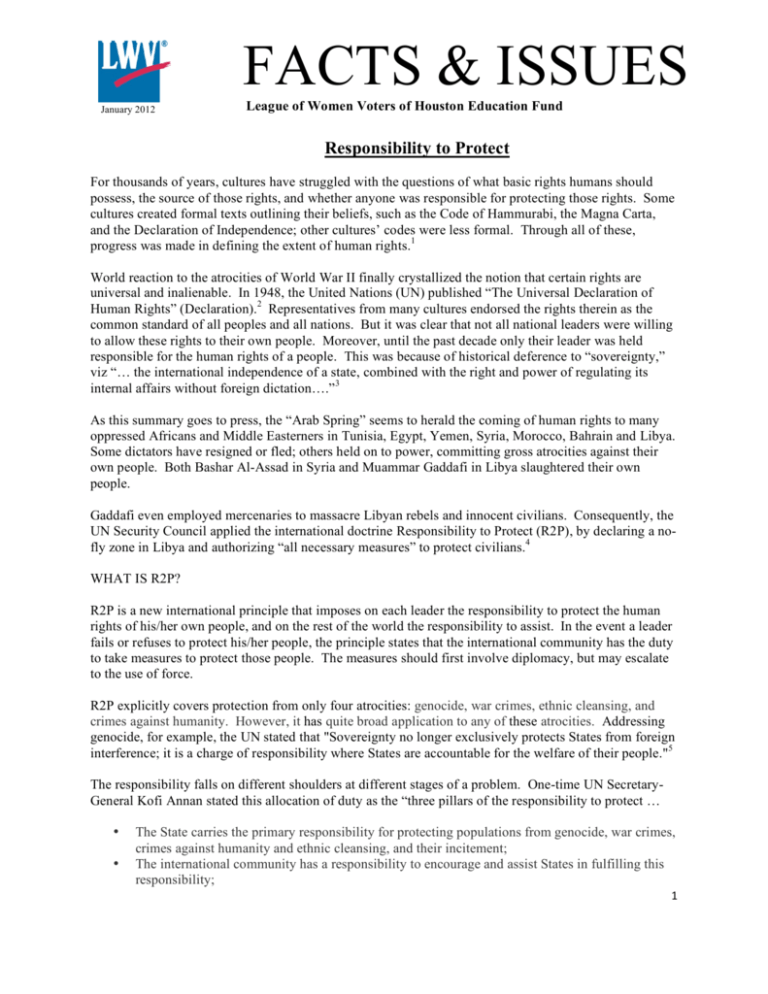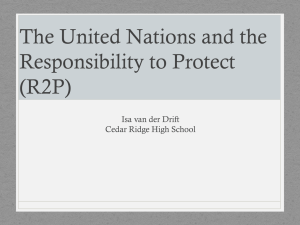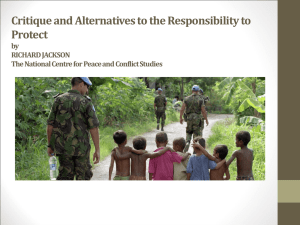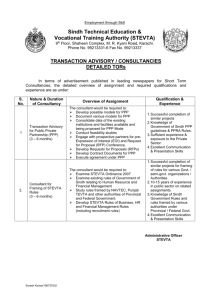FACTS & ISSUES - the League of Women Voters of the Houston Area
advertisement

FACTS & ISSUES January 2012 League of Women Voters of Houston Education Fund Responsibility to Protect For thousands of years, cultures have struggled with the questions of what basic rights humans should possess, the source of those rights, and whether anyone was responsible for protecting those rights. Some cultures created formal texts outlining their beliefs, such as the Code of Hammurabi, the Magna Carta, and the Declaration of Independence; other cultures’ codes were less formal. Through all of these, progress was made in defining the extent of human rights.1 World reaction to the atrocities of World War II finally crystallized the notion that certain rights are universal and inalienable. In 1948, the United Nations (UN) published “The Universal Declaration of Human Rights” (Declaration).2 Representatives from many cultures endorsed the rights therein as the common standard of all peoples and all nations. But it was clear that not all national leaders were willing to allow these rights to their own people. Moreover, until the past decade only their leader was held responsible for the human rights of a people. This was because of historical deference to “sovereignty,” viz “… the international independence of a state, combined with the right and power of regulating its internal affairs without foreign dictation….”3 As this summary goes to press, the “Arab Spring” seems to herald the coming of human rights to many oppressed Africans and Middle Easterners in Tunisia, Egypt, Yemen, Syria, Morocco, Bahrain and Libya. Some dictators have resigned or fled; others held on to power, committing gross atrocities against their own people. Both Bashar Al-Assad in Syria and Muammar Gaddafi in Libya slaughtered their own people. Gaddafi even employed mercenaries to massacre Libyan rebels and innocent civilians. Consequently, the UN Security Council applied the international doctrine Responsibility to Protect (R2P), by declaring a nofly zone in Libya and authorizing “all necessary measures” to protect civilians.4 WHAT IS R2P? R2P is a new international principle that imposes on each leader the responsibility to protect the human rights of his/her own people, and on the rest of the world the responsibility to assist. In the event a leader fails or refuses to protect his/her people, the principle states that the international community has the duty to take measures to protect those people. The measures should first involve diplomacy, but may escalate to the use of force. R2P explicitly covers protection from only four atrocities: genocide, war crimes, ethnic cleansing, and crimes against humanity. However, it has quite broad application to any of these atrocities. Addressing genocide, for example, the UN stated that "Sovereignty no longer exclusively protects States from foreign interference; it is a charge of responsibility where States are accountable for the welfare of their people."5 The responsibility falls on different shoulders at different stages of a problem. One-time UN SecretaryGeneral Kofi Annan stated this allocation of duty as the “three pillars of the responsibility to protect … • • The State carries the primary responsibility for protecting populations from genocide, war crimes, crimes against humanity and ethnic cleansing, and their incitement; The international community has a responsibility to encourage and assist States in fulfilling this responsibility; 1 • The international community has a responsibility to use appropriate diplomatic, humanitarian and other means to protect populations from these crimes. If a State is manifestly failing to protect its populations, the international community must be prepared to take collective action to protect populations, in accordance with the Charter of the United Nations.”6 The history of R2P begins with incidents of massive atrocities in many states of the world and progresses through the following major events. 1. The international community failed to respond to the 1994 genocide in Rwanda. It did respond in 1995 in Serbia, with what some considered excessive force. In 2000, Kofi Annan challenged the global community: “[I]f humanitarian intervention is, indeed, an unacceptable assault on sovereignty, how should we respond to a Rwanda, to a Srebrenica—to gross and systematic violations of human rights that affect every precept of our common humanity?”7 2. The Canadian government responded to the challenge in September 2000 by establishing the International Commission on Intervention and State Sovereignty (ICISS), headquartered in Brussels. The ICISS consisted of representatives from a broad range of nations, who quickly recommended that the international community implement R2P when called upon to do so by an international institution like the UN. But implementation implied intervention, which clearly would conflict with the long-standing principle of sovereignty. 3. In its founding charter of 2005, the African Union adopted the doctrine of R2P, making all member states subject to R2P.8 4. The 2005 UN World Summit issued its final document (Outcome Document) adopting R2P. Paragraphs 138 and 139 spell out clear and unambiguous acceptance by all governments of the collective international responsibility “to protect populations from genocide, war crimes, ethnic cleansing and crimes against humanity”; and to take timely and decisive collective action for this purpose through the Security Council when peaceful means prove inadequate and national authorities are manifestly failing to do it.9 One hundred ninety-one members of the UN have signed this document.10 5. In April 2006, the UN Security Council (UNSC) reaffirmed the provisions of R2P adopted by the 2005 World Summit in Resolution 1674 (UNSC R1674).11 This was the first discussion of R2P implementation or enforcement. The Resolution detailed protections for civilian populations during armed conflict, and the principle of “Responsibility to Protect” became a key concept. 6. In January 2009, then Secretary General Ban Ki-Moon wrote a report on implementing R2P.12 The report was followed in July 2009 by a General Assembly debate on the subject. A resolution was adopted (63/308 The responsibility to protect) that simply says, "The General Assembly ... [d]ecides to continue its consideration of the responsibility to protect".13 Following adoption of the vote, nine countries took the floor to explain their vote. Of these Venezuela, Cuba, Syria, Sudan, Iran, Ecuador, and Nicaragua stressed that the resolution was solely procedural and expressed their opposition to the concept. Uncertainties still exist about the exercise of R2P, some based on disagreements among nations on how to interpret “responsibility,” and some based on the complexities of applying the principle in a particular situation: • LEGAL. The UN Charter, in Article 2.4,14 reinforces the concept of sovereignty of borders, thereby imposing a threshold for application of R2P. Because R2P is authorized specifically for certain crimes, but those crimes are not defined in the UN Resolution authorizing R2P, international law on specific crimes has a bearing on whether an action is justified, and global 2 politics will play a part in deciding whether a situation falls within the four justifying crimes. Regional organizations, such as the Association of Southeast Asian Nations, and international organizations, such as the International Criminal Court (ICC), may have some jurisdiction and impose restrictions, or they may themselves be involved in protective actions in conflict with the greater international community • LOGISTICAL. Whether an R2P operation can take place may be determined by whether: (a) anyone will do it; (b) it will conflict with the good others are doing, such as the ICC in Libya; (c) the impacted government’s response will cause more harm (again, as in Libya); (d) an effective response is feasible; and (e) the action will result in more harm than good. • SEVERITY OF THE PROBLEM. Some actions by a government against its people may not rise to the level of genocide or crimes against humanity. • INTERNAL POLITICS. A case in point is the oppression of the Shi’a majority in Bahrain, which the international community apparently ignores, likely because Bahrain is a necessary ally in the Middle East. • CAPABILITY: Which nations are able to act on the responsibility? The signatories to the Outcome Document have agreed to cooperate to achieve required readiness. Furthermore, some nations, including the United States, have not accepted an obligation to implement R2P. Finally, there are many more populations to protect than UN members with means to protect them. OTHER CONSIDERATIONS The principle of R2P is a substantially new concept in the affairs of nations. Some have termed it a nascent norm on the leading edges of international law and, as with any new principle, there are considerations to be weighed when formulating it. For R2P, one should consider: • • • • • • • • Does the Universal Declaration of Human Rights imply a responsibility of nations to protect human rights? Upon whom does the responsibility rest? Who determines that responsibility? At what level does abuse warrant intervention? How is civil war distinguished from civil uprising? What action is permitted? What happens to sovereignty? Might wrongful intervention be done in the name of R2P? The principle of R2P has been developed and clarified over recent years as circumstances have produced pragmatic answers to some of these questions. As previously noted, Kofi Annan posed a tough question: "If humanitarian intervention is, indeed, an unacceptable assault on sovereignty, how should we respond to a Rwanda, to a Srebrenica – to gross and systematic violations of human rights that offend every precept of our common humanity?" The question itself suggests answers to several of the considerations. The responsibility to protect human rights arises from our common sharing of them. He asks the UN, “How should we respond?”, which suggests that the responsibility rests on the global assembly of nations. He also says “gross and systematic violations of human rights” (unacceptable even in civil war) are to be addressed. And he rejects sovereignty as a shield against humanitarian intervention. His single comment addresses a number of considerations implicit in R2P. 3 The ICISS report in 2001 proposed that R2P would be actionable when it met six tests. Action must be: 1) the last resort, 2) rightly intentioned, 3) of proportionate means, 4) likely to succeed, 5) with international sanction, 6) in a just cause (e. g., addressing large scale loss of life). This leaves at least two matters unresolved: infringement of sovereignty and security from misuse of R2P. Today’s views on sovereignty vary greatly, from inviolable to outdated, and may in a particular instance reflect the degree to which a nation feels secure. The possible misuse of R2P thus matters particularly to smaller nations that think R2P is a western concept that could be used by stronger nations to achieve their global agenda to the detriment of weaker nations. New norms of behavior between nations take time to become established and R2P is no exception. THE UNITED STATES AND R2P There is a general sympathy in the US for the protection of all nations’ human rights as expressed in the 1948 Declaration. However, current US policy on protecting human rights is subordinate to foreign policy considerations. In 2005, then US Ambassador to the UN, John Bolton, stated flatly that, regardless of the need, these resolutions did not create a legal obligation to intervene: "We do not accept that either the UN as a whole, or the Security Council, or individual states, have an obligation to intervene under international law."15 Despite widespread concern for the human tragedy in a particular circumstance, policy issues have often dictated US response. In 1999, before the formalization of R2P, the US, in collaboration with NATO, intervened to free Kosovo from Serbian control to end the slaughter of Bosnian Muslims. It failed to act in Rwanda: then President Clinton refused to provide air transportation to enable European intervention to stop the slaughter of Tutsis, 800,000 of whom died. Clinton's action followed his withdrawal of US troops from a UN action to protect civilians in Somalia after 18 US Army Rangers were killed in an ambush. And the US did not actively support UN humanitarian action to protect civilians in Zimbabwe from Robert Mugabe (although any action would have been vetoed by China and Russia in any event), nor did it support intervention to end Sudan's ethnic-tribal slaughter in Darfur (300,000 dead and 2 million refugees), which, with other nations, the US condemned as genocide. Current political uprisings in Middle Eastern and North African countries to overthrow long-term repressive rulers have had the US scrambling to put aside past support of these regimes and associate itself with the new regimes. Special problems [as of the printing of this summary] remain in Libya, where the US provided limited air power to overthrow Gaddafi; in Syria, where the dictator's powerful army is violently repressing what started as a peaceful national protest; and in Bahrain, where a Sunni ruler has long repressed a large Shi’a majority. In Bahrain it appears the US’s long friendly relations with the Sunni rulers, including permission for the US’s major naval base in the Persian Gulf, and its fear that the Shi’a population might provide future support to Shi’a Iran, outweigh any “responsibility to protect” the rights of the population. It seems likely that our future policy decisions may place an increased emphasis on human rights/R2P. Decisions will need to address human rights, the duty of humanitarian rescues, and the erosion of sovereignty. Prepared by the International Affairs Committee, Marge O’Connor, Chair; Bert Golding; Henry Horne; Joan Golding; Louis Whittington; Millie Whittington; Patricia Cunningham NOTE: Many documents referenced in the body and footnotes of this document are available online, on the local League of Women Voters website (www.lwvhouston.org). Footnotes will indicate they are “on 4 the LWVHA website.” While not necessary for the purposes of this document and resulting discussions, they add depth to the understanding of R2P. ENDNOTES 1 Examples are listed in the Appendix, available on the LWVHA website, http://www.lwvhouston.org . See Appendix on the LWVHA website. 3 th Black's Law Dictionary 1568 (4 ed. Rev. 1968) 4 http://www.un.org/News/Press/docs/2011/sc10200.doc.htm 5 Office of the Special Adviser on the Prevention of Genocide Report issued July 2010. http://www.un.org/en/preventgenocide/adviser/pdf/osapg_booklet_eng.pdf 6 UN: Office of the Special Advisor on the Prevention of Genocide. http://www.un.org/en/preventgenocide/adviser/responsibility.shtml; http://www.un.org/en/preventgenocide/adviser/pdf/osapg_booklet_eng.pdf 7 UN Secretary‐General, We the Peoples: The Role of the United Nations in the Twenty‐First Century: Rep. of the Secretary‐General, ¶ 217, UN Doc. A/54/2000 (Mar. 27, 2000.) See Appendix on the LWVHA website. 8 http://www.au2002.gov.za/docs/key_oau/au_act.htm, in Article 4. 9 2005 World Summit Outcome Document, http://daccess‐dds‐ ny.un.org/doc/UNDOC/GEN/N05/487/60/PDF/N0548760.pdf?OpenElement, at page 30. Paragraphs 138‐139 of the World Summit Outcome Document : Heads of state and government agreed to the following text on the Responsibility to Protect in the Outcome Document of the High‐level Plenary Meeting of the General Assembly in September 2005 138. Each individual State has the responsibility to protect its populations from genocide, war crimes, ethnic cleansing and crimes against humanity. This responsibility entails the prevention of such crimes, including their incitement, through appropriate and necessary means. We accept that responsibility and will act in accordance with it. The international community should, as appropriate, encourage and help States to exercise this responsibility and support the United Nations in establishing an early warning capability. 139. The international community, through the United Nations, also has the responsibility to use appropriate diplomatic, humanitarian and other peaceful means, in accordance with Chapters VI and VIII of the Charter, to help protect populations from genocide, war crimes, ethnic cleansing and crimes against humanity. In this context, we are prepared to take collective action, in a timely and decisive manner, through the Security Council, in accordance with the Charter, including Chapter VII, on a case‐by‐case basis and in cooperation with relevant regional organizations as appropriate, should peaceful means be inadequate and national authorities manifestly fail to protect their populations from genocide, war crimes, ethnic cleansing and crimes against humanity. We stress the need for the General Assembly to continue consideration of the responsibility to protect populations from genocide, war crimes, ethnic cleansing and crimes against humanity and its implications, bearing in mind the principles of the Charter and international law. We also intend to commit ourselves, as necessary and appropriate, to helping States build capacity to protect their populations from genocide, war crimes, ethnic cleansing and crimes against humanity and to assisting those which are under stress before crises and conflicts break out. 140. We fully support the mission of the Special Adviser of the Secretary‐General on the Prevention of Genocide 10 Current UN membership is 193 countries. Three countries remain outside the UN, two which lack international recognition (Kosovo and Taiwan) and one which has chosen not to join (Vatican City.) 11 See Appendix on the LWVHA website. 12 http://responsibilitytoprotect.org/SGRtoPEng%20%284%29.pdf 13 http://daccess‐dds‐ny.un.org/doc/UNDOC/GEN/N09/513/38/PDF/N0951338.pdf?OpenElement 14 See Appendix on the LWVHA website. 15 See Ambassador Bolton’s full letter explaining the US position in the Appendix on the LWVHA website. 2 5







